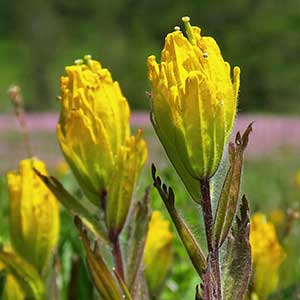Castilleja levisecta
Castilleja chrymactis
golden Indian paintbrush, golden paintbrush
green Indian paintbrush, green paintbrush
few to many, erect, ± decumbent or creeping at base, unbranched, sometimes branched, hairs spreading, medium length and long, soft, mixed with short stipitate-glandular ones.
several to many, erect to ascending, unbranched or branched, sometimes with short, leafy axillary shoots, glabrous or hairs sparse proximally, distally spreading-erect, long, soft, eglandular, mixed with shorter ones.
green to purple or brown-tinged, linear-lanceolate proximally, oblong-ovate or -obovate distally, 0.8–5.2 cm, not fleshy, margins plane, distalmost sometimes ± wavy, involute, 3–7(–11)-lobed, apex obtuse;
lobes erect to ascending, linear to linear-spatulate, very short, toothlike, usually arising from distal 1/3 of blade, apex rounded.
green or purple-tinged, sometimes deep purple, linear-lanceolate to lanceolate or ovate, (1.5–)5–11.7 cm, not fleshy, margins plane, sometimes ± wavy, flat or involute, 0–3(–5)-lobed, apex acute to obtuse, sometimes rounded;
lobes erect or ascending, linear, apex acute or acuminate.
2.5–25 × 1–4 cm;
bracts bright yellow throughout, or proximally greenish, distally bright yellow, sometimes deep yellow-orange, especially with age, oblong, elliptic, or obtuse to ovate, (0–)5–9(–13)-lobed, sometimes wavy-margined;
lobes erect to ascending, oblong, short to medium length, arising above mid length, central lobe apex rounded, lateral ones rounded to acute.
3.5–18 × 3–7.5 cm;
bracts proximally pale green to dull purplish, distally bright red or scarlet to yellow, orange, yellow-orange, and salmon, sometimes tricolored with central band of deeper purple or deeper shade of the far-distal color, broadly lanceolate, oblong, elliptic, or oblong, 0–3(–9)-lobed;
lobes ascending, lanceolate, triangular, or oblong, short, arising at or above mid length, central lobe apex rounded, lateral ones acute to obtuse.
straight or slightly curved, 17–28 mm;
tube 12–15 mm;
beak exserted, adaxially green or greenish yellow, 6–8 mm;
abaxial lip yellow or greenish, reduced, not inflated, 2–3 mm, 25–33(–50)% as long as beak;
teeth ascending to erect, yellow, 0.5–1.5 mm.
straight to slightly curved, 26–43 mm;
tube 16–24 mm;
beak exserted, adaxially green to yellow, 9–19 mm;
abaxial lip whitish or dark green, reduced, not exserted, sometimes visible through front calyx cleft, 1.5–2 mm, 20% as long as beak, glabrous or sparsely hairy, hairs spreading;
teeth reduced, incurved, deep green, 0.5–1 mm.
distally yellow, 13–22 mm;
abaxial and adaxial clefts 4–9.5 mm, 30–40% of calyx length, deeper than laterals, lateral 2.5–4.5 mm, ca. 25% of calyx length;
lobes linear to narrowly oblong or narrowly lanceolate, apex obtuse, sometimes rounded to acute.
colored as bracts, sometimes more deeply pigmented and contrasting with bract coloration, 24–31 mm;
abaxial and adaxial clefts 12–19 mm, 45–65% of calyx length, deeper than laterals, lateral 7–11 mm, 25–32% of calyx length;
lobes lanceolate, narrowly triangular, or almost oblong, apex acute, sometimes obtuse or acuminate.
= 24.
Castilleja levisecta
Castilleja chrymactis
Castilleja levisecta is listed as threatened in the United States and endangered in Canada, where it is extremely rare. Most of its grassland habitat has been altered by development in the Puget Trough, and there are historical stations in the metro areas of what are now Victoria, Portland, and Seattle. For several decades, C. levisecta was considered extirpated from Oregon. However, recent reintroduction programs in Oregon and Washington have been very successful at reestablishing this species at several sites in the Willamette Valley. The bright yellow inflorescences often gradually age to a golden yellow color, unique in the genus.
Castilleja levisecta is in the Center for Plant Conservation’s National Collection of Endangered Plants.
(Discussion copyrighted by Flora of North America; reprinted with permission.)
Castilleja chrymactis is restricted to the coast of southeastern Alaska, from Glacier Bay to Yakutat. In some respects, it resembles a hybrid swarm between C. miniata and C. unalaschcensis. If C. chrymactis originated as a hybrid, at present it has formed a number of populations and has a stable morphology that differs from both putative parents, especially in calyx structure. Reports of its introduction to Point Reyes, California (T. I. Chuang and L. R. Heckard 1993b), are based on C. leschkeana, a distinctive species known only from two records near the type locality and presumed to be extinct.
(Discussion copyrighted by Flora of North America; reprinted with permission.)


